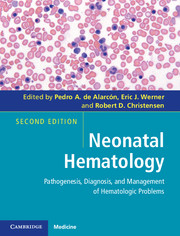Book contents
- Frontmatter
- Contents
- Contributors
- Foreword
- Preface
- 1 A historical review
- Section I Developmental hematology
- Section II Erythrocyte disorders
- 4 Anemia of prematurity and erythropoietin therapy
- 5 Bone marrow failure syndromes
- 6 Hemolytic disease of the fetus and newborn
- 7 Neonatal hemolysis
- 8 Neonatal screening for red blood cell disorders
- 9 Polycythemia and hyperviscosity in the newborn
- Section III Platelet disorders
- Section IV Leukocyte disorders
- Section V Immunologic disorders
- Section VI Hemostatic disorders
- Section VII Transfusional medicine
- Section VIII Miscellaneous
- Index
- Plate section
- References
4 - Anemia of prematurity and erythropoietin therapy
from Section II - Erythrocyte disorders
Published online by Cambridge University Press: 05 February 2013
- Frontmatter
- Contents
- Contributors
- Foreword
- Preface
- 1 A historical review
- Section I Developmental hematology
- Section II Erythrocyte disorders
- 4 Anemia of prematurity and erythropoietin therapy
- 5 Bone marrow failure syndromes
- 6 Hemolytic disease of the fetus and newborn
- 7 Neonatal hemolysis
- 8 Neonatal screening for red blood cell disorders
- 9 Polycythemia and hyperviscosity in the newborn
- Section III Platelet disorders
- Section IV Leukocyte disorders
- Section V Immunologic disorders
- Section VI Hemostatic disorders
- Section VII Transfusional medicine
- Section VIII Miscellaneous
- Index
- Plate section
- References
Summary
Physiology of anemia of prematurity
Erythropoietin (EPO), the primary hormone regulating erythropoiesis, is measurable throughout fetal gestation (1). In the fetus and newborn, EPO is produced primarily by the liver, which may be relatively insensitive to hypoxia, compared to the kidneys (1, 2). During the first postpartum months after term birth, erythropoiesis is suppressed by markedly improved postnatal oxygen delivery and a relatively depressed plasma EPO levels, resulting in a “physiologic nadir” in hemoglobin (Hb) (3). This response is exaggerated in premature infants (4). The anemia of prematurity reflects not only insufficient EPO production (4), but also small circulating blood volume, iatrogenic blood loss, hemorrhage, hemolysis and shortened red blood cell (RBC) survival (summarized by Ohls) (5). Anemia of prematurity is traditionally described as nutritionally “insensitive,” although iron contributes to the recovery of Hb (6, 7). Iron status is critical, in that insufficient iron supplementation may inhibit the efficacy of EPO in prematurity (7, 8).
Therapy for anemia of prematurity
Minimizing blood loss
Blood loss impacts the clinical course of the anemia of prematurity. In a typical 800 gram birthweight premature infant, with red cell mass at birth of 27 mL, avoidance of blood transfusions depends on avoidance of blood loss (9). In the presence or absence of EPO, phlebotomy volume clearly correlates to erythrocyte volume transfused (9–17). This observation is most evident when precise transfusion criteria are employed (13). Some centers report relatively lower phlebotomy loss on even the smallest children (18, 19). Using inline and microsampling point-of-care testing may contribute to less blood loss in unstable infants (16, 20, 21). With such small circulating blood volumes, phlebotomy volume, as well as phlebotomist overdraw volumes relate to volume transfused (9, 22, 23). It is logical that advances in perinatal care which may decrease patient acuity would also decrease transfusions (11), but inter-institutional transfusion practices on infants with similar acuity vary widely (13–15).
- Type
- Chapter
- Information
- Neonatal HematologyPathogenesis, Diagnosis, and Management of Hematologic Problems, pp. 37 - 46Publisher: Cambridge University PressPrint publication year: 2013
References
- 2
- Cited by

